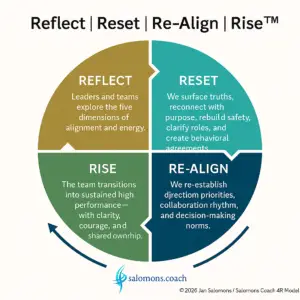Strong emotions aren’t the problem! Your Frame is. Change it!

A practical guide to reframe your perspective
Emotions are not weaknesses — they are data. They reveal what matters, what’s at risk, and where growth is possible. Yet in many workplaces, especially in high-pressure or performance-driven environments, strong emotions like anger, fear, or sadness are often viewed as something to control or avoid.
Take this example: a senior operations manager feels angry after a team meeting where deadlines keep slipping. His instinct is to suppress the emotion — after all, “professionals don’t get emotional.” But when we unpack this reaction in coaching, it turns out the anger isn’t about the delay itself. It’s about feeling that accountability has faded, and that the team’s standards are slipping. Once he reframes the emotion, the energy shifts — anger becomes clarity, and frustration becomes a constructive conversation about ownership.
Reframing means looking at a situation from a different perspective — shifting the lens through which we interpret what’s happening. Instead of reacting to the first emotional signal, we pause, step back, and ask: What else could this mean? What can I learn from it? In coaching, reframing helps people move from “why is this happening to me?” to “what can this teach me?” It turns emotion into insight and helps leaders make choices that are both grounded and growth-oriented.
In a VUCA world — volatile, uncertain, complex, and ambiguous — this ability is not optional. Every day, leaders face surprises, setbacks, and pressures that naturally evoke strong emotions. Volatility triggers fear, uncertainty fuels doubt, complexity overwhelms, and ambiguity frustrates. The difference between reacting and reframing determines whether you spiral into stress or step into leadership. Reframing turns emotional reactions into strategic awareness — it’s how leaders create stability for themselves and their teams when the environment offers none.
As a coach and leadership developer, I’ve seen this pattern repeatedly. Strong emotions, when understood and reframed, can become sources of strength and learning. They connect us to our values, sharpen our awareness, and make us more effective as leaders and human beings. In this post, I’ll share practical ways to reframe strong emotions — to turn reactivity into reflection, and reflection into growth.
Recognize and acknowledge
The first step is simple, but rarely easy: acknowledge what you feel. Most leaders have been trained to stay composed and rational — but suppressing emotions only makes them louder over time. Instead, take a moment to name what’s happening: “I feel frustrated.” “I feel anxious.” “I feel let down.” Naming your emotion doesn’t mean you lose control — it means you start to understand your own data. This self-awareness is the foundation of emotional intelligence and the first step toward transformation.
Practice mindfulness in the moment
Mindfulness helps create space between what you feel and how you act. It’s not about emptying your mind — it’s about noticing. Breathe, pause, or take a short walk before reacting. In my coaching sessions, I often encourage leaders to use a simple mental cue: Pause. Breathe. Observe. Choose. Over time, this small discipline helps you respond from clarity rather than impulse — an essential skill in a VUCA world where every reaction ripples through teams and systems.
Explore the root cause
Strong emotions often signal a value being challenged. Anger might indicate injustice, fear might signal risk, sadness might reflect loss or misalignment. Instead of judging these emotions, explore their origin: What need or value is at stake? What story am I telling myself about this situation? What am I protecting, or what do I fear losing? This reflection shifts your energy from reaction to learning — and helps you identify what truly needs to change.
Challenge the story behind the emotion
Once you see the emotion, examine the story attached to it. Ask yourself: Is this belief factual or assumed? What’s another possible interpretation? What evidence do I really have? Reframing starts here — not by denying emotions, but by revisiting the narrative that fuels them. This is where coaching conversations often lead to breakthroughs: when leaders realize they’ve been reacting to an assumption rather than reality.
Seek other perspectives
Emotions can narrow our lens; connection widens it. Talk with someone you trust — a peer, coach, or team member — and explore how they see the situation. Listening to different perspectives not only helps regulate emotion, it expands understanding and empathy. In teams, this practice creates psychological safety and builds cultures where reflection replaces blame.
Cultivate emotional intelligence
Strong emotions are the training ground for emotional intelligence (EQ). EQ is not about staying calm at all times — it’s about understanding, integrating, and using emotions to guide better decisions. High-EQ leaders don’t hide emotion; they use it wisely to strengthen communication, build trust, and sustain focus under pressure. As Daniel Goleman’s research and Harvard Business Review studies confirm, self-awareness and emotional regulation are among the top predictors of leadership effectiveness — more than technical expertise or IQ.
Channel emotion into action or creation
Emotion is energy. The key is to direct it. When used consciously, it fuels creativity, courage, and resilience. Write, paint, exercise, or brainstorm solutions — do something that transforms emotion into movement. In my workshops, I often invite leaders to express emotions through metaphor, drawing, or storytelling — it’s a surprisingly powerful way to process feelings and access deeper insight.
Practice self-care and compassion
Strong emotions demand energy. Recovering that energy is part of the work. Sleep well, stay active, connect with people who lift you up, and practice compassion toward yourself. Leaders who neglect self-care eventually lose their capacity to hold space for others. Emotional resilience starts with self-kindness, not self-criticism.
From Reaction to Reflection — The Leadership Edge
In a VUCA world — volatile, uncertain, complex, and ambiguous — leaders who can reframe emotions have a real advantage. They navigate turbulence without losing themselves. They turn setbacks into learning, and conflict into connection. This ability to pause, reflect, and reframe is what I call leading from awareness — a skill that keeps leaders grounded when the environment isn’t.
Reflection for leaders
What strong emotion has shown up for you recently — and what might it be trying to tell you? The message behind the feeling is often the key to your next step in growth.
Work with me
In my coaching and leadership programs, I regularly bring this topic forward in a very practical, experiential way — because emotional awareness isn’t learned from a book; it’s learned by doing, reflecting, and trying again. If this resonates with you or your team, let’s talk. Together we can turn strong emotions into stronger leadership — creating awareness, ownership, and outcomes that last.




